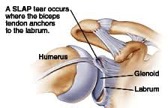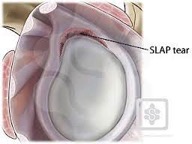WHAT IS A SLAP LESION?
A SLAP tear or SLAP lesion is an injury to the glenoid labrum (fibrocartilaginous rim attached around the margin of the glenoid cavity). The acronym ‘SLAP’ refers to superior labrum anterior and posterior.
A circumferential rim of fibrocartilaginous tissue called the labrum firmly attaches to the glenoid fossa (shoulder socket) thereby increasing the articular surface area and the stabilisation of the glenohumeral joint. The long tendon of the biceps inserts directly into the superior labrum, which also provides stabilisation to the superior part of the joint.

ANATOMY OF THE SHOULDER
A total of four types of superior labral lesions involving the biceps anchor have been identified.
Type I concerns degenerative fraying with no detachment of the biceps insertion.
Type II is the most common type and represents a detachment of the superior labrum and biceps from the glenoid rim.
Type III represents a bucket-handle tear of the labrum with an intact biceps tendon insertion to the bone.
Type IV lesions, the least common type represents an intra-substance tear of the biceps tendon with a bucket-handle tear of the superior aspect of the labrum.

WHAT ARE THE SYMPTOMS OF A SLAP LESION?
The most common complaint in patients that present with SLAP lesions is pain. Pain is typically intermittent and often associated with overhead movements. Isolated SLAP lesions are uncommon. The majority of patients with SLAP lesions will also complain of:
- sensations of painful clicking and/or popping with shoulder movement
- loss of glenohumeral internal rotation range of motion
- pain with overhead motions
- loss of rotator cuff muscular strength and endurance
- loss of scapular stabiliser muscle strength and endurance
- inability to lie on the affected shoulder
DO I HAVE A SLAP LESION?
There are a lot of different mechanisms of injury that can result in a SLAP lesion. The following causes have been found:
- repetitive throwing
- hyperextension
- a fall on an outstretched arm
- heavy lifting
- direct trauma
The two most common mechanisms are falling on an outstretched arm in which there is a superior compression and a traction injury in the inferior direction.
SLAP lesions are difficult to diagnose as the symptoms are very similar to those of instability and rotator cuff disorders. MRI is the most common imaging tool used to diagnose labral lesions, although it may not pick up a SLAP lesion in 100% of cases.
TREATMENT OF SLAP TEARS
Strength, stability and range of motion are the components of shoulder function that should be focused on during rehabilitation.
Conservative treatment should focus on restoring strength of the rotator cuff, shoulder girdle, trunk, core and scapular musculature, restoring normal shoulder motion, and training to improve dynamic joint stability.
In throwing athletes, a progressive throwing program that is directed toward the patients' specific sport and position can be initiated after 3 months.
When conservative treatment fails, a surgical approach may be required to repair the labrum. Throwing athletes often require a surgical repair due to the high demands they place on their shoulder.
DIFFERENTIAL DIAGNOSIS
SLAP lesions are often seen in combination with other shoulder problems and this makes it difficult to diagnose. Besides biceps tears, other problems, such as bursitis and rotator cuff tears, are often identified.
REFERENCES
SNYDER SJ et al., SLAP lesions of the shoulder. Arthroscopy., 1990;6:274–279
CHRISTOPHER C. et al., SLAP Lesions: An Update on Recognition and Treatment. J Orthop Sports Phys Ther, 2009; 39(2):71-80
POWELL S.E. et al., The Diagnosis, Classification, and Treatment of SLAP Lesions. Oper Tech Sports Med, 2012;20 (1):46 – 56
PEAT M., Functional anatomy of the schoulder complex. Phys Ther., 1986;66:1855-1865
CARMICHAEL S.W. et al., Anatomy of the Shoulder Joint. The Journal Of Orthopaedic And Sports Physical Therapy, 1985;6(4):225-228
KOZIAK A. et al, Magnetic resonance arthrography assessment of the superior labrum using the BLC system: age-related changes mimicking SLAP-2 lesions. Skeletal Radiology, 2014;43: 1065 – 1070
WILK K.E. et al, The recognition and treatment of superior labral (SLAP) lesions in the overhead athlete. Int. J. Sports Phys. Ther., 2013; 8(5): 579-600
HURI G. et al, Treatment of superior labrum anterior posterior lesions: a literature review. Acta Orthop Traumatol Turc., 2014;48(3): 290-297
MANSKE R. et al., Superior labrum anterior to posterior (SLAP) rehabilitation in the overhead athlete. Phys Ther Sport., 2010;110-121
SACCOL M.F. et al., Shoulder rotator strength and torque steadiness in athletes with anterior shoulder instability or SLAP lesion. Journal of Science and Medicine in Sport, 2014;17(5): 463–468
Need additional help
Our team at Physica are here to help you with all of your musculoskeletal conditions. Please book online using the link in the header or if you have additional questions prior to bookings contact us via email.
